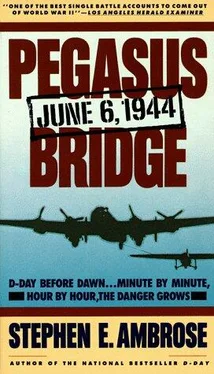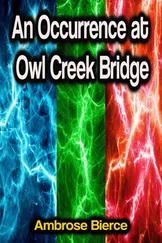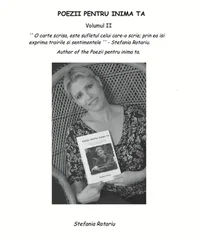Stephen Ambrose - Pegasus Bridge
Здесь есть возможность читать онлайн «Stephen Ambrose - Pegasus Bridge» весь текст электронной книги совершенно бесплатно (целиком полную версию без сокращений). В некоторых случаях можно слушать аудио, скачать через торрент в формате fb2 и присутствует краткое содержание. Жанр: История, на английском языке. Описание произведения, (предисловие) а так же отзывы посетителей доступны на портале библиотеки ЛибКат.
- Название:Pegasus Bridge
- Автор:
- Жанр:
- Год:неизвестен
- ISBN:нет данных
- Рейтинг книги:5 / 5. Голосов: 1
-
Избранное:Добавить в избранное
- Отзывы:
-
Ваша оценка:
- 100
- 1
- 2
- 3
- 4
- 5
Pegasus Bridge: краткое содержание, описание и аннотация
Предлагаем к чтению аннотацию, описание, краткое содержание или предисловие (зависит от того, что написал сам автор книги «Pegasus Bridge»). Если вы не нашли необходимую информацию о книге — напишите в комментариях, мы постараемся отыскать её.
Pegasus Bridge — читать онлайн бесплатно полную книгу (весь текст) целиком
Ниже представлен текст книги, разбитый по страницам. Система сохранения места последней прочитанной страницы, позволяет с удобством читать онлайн бесплатно книгу «Pegasus Bridge», без необходимости каждый раз заново искать на чём Вы остановились. Поставьте закладку, и сможете в любой момент перейти на страницу, на которой закончили чтение.
Интервал:
Закладка:
Out of all this practice and after consulting with his officers, Howard made his final plan. The key to it was to put the pillbox out of action while simultaneously getting a platoon onto the other side of the bridge. It had to be accomplished before shots were fired, if possible, and certainly before the Germans were fully aroused. The pillbox was a key not only because of its firing power, but because - according to information received from Georges Gondree - that was the location of the button that could blow the bridge. Howard detailed three men from no. 1 glider (Brotheridge's platoon) to dash to the pillbox and throw grenades through the gun-slits. To take physical possession of the opposite bank, Howard detailed Brotheridge to lead the remainder of his platoon on a dash across the bridge. Ideally, Howard wanted Brotheridge to hear the thuds of the grenades in the pillbox as he was mid-way across the bridge.
No. 2 glider, David Wood's platoon, would clear up the inner defences, the trenches, machine-gun nests and anti-tank gun pit along the east bank. No. 3 glider, Sandy Smith's platoon, would cross the bridge to reinforce Brotheridge. On the river bridge, the procedure would be the same, with Friday in no. 4 glider (Hooper's platoon), Sweeney in no. 5, and Fox in no. 6. All six platoons were trained to do all six of the platoon tasks.
Each glider would carry five sappers, the thirty men under the command of Captain R. K. Jock Neilson. The sappers' main job was to move immediately to the bridges, then hand-over-hand themselves along the bottom beams, cutting fuses and disposing of explosives.
If all went well at both bridges, Howard intended to call two platoons from the river bridge over to the canal bridge, sending one towards Benouville as a fighting patrol, and holding the other in reserve. This was because the threat he faced lay to the west. That was German-occupied territory, with a garrison of some sort in every village. The first counter-attack was likely to come from the west, possibly led by tanks. To the east, the 6th Airborne Division would be dropping thirty minutes later and setting up in Ranville to provide protection in that direction.
The landing operation was John Howard's plan. His superiors let him work it out himself, then approved his final presentation. He ran through it again and again, until the men were exhausted and almost too tense and too bored to care any longer.
But each time he ran through it, Howard saw something he had overlooked. One day, for example, he stopped an exercise and said he had been thinking, that if so and so happened, and such and such, I'd need volunteers to swim the canal with a Bren gun to set up flanking fire, or to create a diversion with explosives. As Howard remembers the occasion, 'competition for this hazardous mission was high'. As Parr remembers it, he raised his hand before Howard could call for volunteers. Howard impatiently told him to put it down. Parr waved it some more. 'Oh, all right Parr, what is it?' Parr replied that since Billy Gray and Charlie Gardner were the two strongest swimmers, perhaps they should get this detail. 'Good idea, Parr', Howard pronounced, and it was done. Parr spent the remainder of the week staying far away from Gray and Gardner.
The last night in Exeter was a classic eve-of-battle event. Howard gave the men the evening off, and they poured into and out of Exeter's pubs. There were fights, windows were broken. The Chief of Police got Howard on the phone, and he and Friday jumped into a jeep and tore into Exeter, about three miles away. 'As we crossed the bridge we were picked up by the police for speeding', recalls Howard, 'and we arrived at the station with police escort'. Howard went straight to the Chief's office and said, 'If you find Lieutenant Brotheridge he will soon tell you how to get the troops back'. Then Howard noticed the Chief's World War I medals, 'and I knew the type of chap I was talking to, and I explained to him in confidence that this was likely to be our last night out; his attitude was absolutely wonderful'. The Chief called out the entire force on duty at the time and put it to rounding up D Company and escorting it, gently, back to its transport and encampment.
Brotheridge, in fact, turned out to be no help, although Howard had sent him along with the men specifically to exert a good influence. But he was too much the footballer, too much like the men, to stay sober on a night like this. Besides, he had a lot on his mind, and he needed some mental relief. His baby was due in less than a month, but he could not expect to see his wife before then, and who could tell about afterwards? He was proud that John had chosen him to lead the first platoon across the canal bridge, but he had to be realistic - everyone knew that the first man over that bridge was the man most likely to get shot. Not killed, necessarily, but almost certainly shot. That first man was equally likely to have the bridge blow up in his face.
To escape such thoughts, Brotheridge had gone drinking with his sergeants, and when Howard arrived was drunk. Howard and Friday drove him back to camp, while the trucks took the men home. The people of Exeter, and their Police Chief, never made a complaint.
In late May, D Company moved to Tarrant Rushton. In a wired-in encampment on this huge base, completely secured, the company met Jim Wallwork, John Ainsworth, Oliver Boland, and the other glider-pilots. Howard immediately found them impressive and was pleased to note that they were absorbed into the company as family members as quickly as the sappers had been.
How dependent D Company was on the pilots became quickly apparent after arrival in Tarrant Rushton. Now that the company was properly sealed in, Howard was free to give his briefing. First to the officers, then to the men, he explained the operation.
Howard covered the walls of the Nissen briefing hut with photographs of the bridges, and had the model in the middle of the room. As he talked, the eyes of the officers and men opened wider and wider - at the amount of intelligence available to them, at the crucial nature of their task, and at the idea of being the first men to touch the soil of France. But what they also noted was the extreme smallness of the LZs, especially on the canal bridge. Having examined the German trench system, and discussed the Germans' weapons and emplacements, the officers - and later the men - were completely confident that they could take the bridges intact. They could, that is,if- and only if- the pilots put them down on the right spots.
The pilots were now into the last days of Deadstick. Calling on the British movie industry for help, the Air Ministry had put together a film. By flipping through thousands of photographs, each ever so slightly different, the producers made a 'moving picture' that depicted the actual flight the pilots would make on D-Day. There was a running commentary.
'The viewer felt as if he were in the cockpit and flying the thing', Wallwork recalls. The commentary told altitude, air speed, bearing, location. When the glider cast off, 'you got the whole sensation of diving a thousand feet and seeing the fields of France coming up towards you'. Level off, check your bearing, turn, check your bearing, turn again, then the bridges were in view. 'You come into this fly-in,' as Wallwork describes the film, 'and you are still on this bearing and the next thing you saw was the tower of the bridge getting nearer and nearer and then the film cuts out as you crash'. The pilots could see the film whenever they wanted, and they watched it often. In his orders Howard had been given very strict instructions about not using the glider pilots in any combatant role. He therefore gave them the task of unloading the gliders after the platoons had landed and attacked in light fighting order. The pilots were then to carry the ammunition, heavy equipment, etc. up to their respective platoons. Howard was well aware that it was a job they would not like at all; he knew only too well that they were the type who would want to join in the initial assault and take part in any ensuing battle. But the pilots had to be got back to England unscathed so as to be able to fly the 1st Airborne Division into action.
Читать дальшеИнтервал:
Закладка:
Похожие книги на «Pegasus Bridge»
Представляем Вашему вниманию похожие книги на «Pegasus Bridge» списком для выбора. Мы отобрали схожую по названию и смыслу литературу в надежде предоставить читателям больше вариантов отыскать новые, интересные, ещё непрочитанные произведения.
Обсуждение, отзывы о книге «Pegasus Bridge» и просто собственные мнения читателей. Оставьте ваши комментарии, напишите, что Вы думаете о произведении, его смысле или главных героях. Укажите что конкретно понравилось, а что нет, и почему Вы так считаете.




![Stephen Ambrose - Citizen Soldiers [Condensed]](/books/346737/stephen-ambrose-citizen-soldiers-condensed-thumb.webp)




